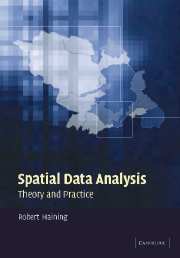Book contents
- Frontmatter
- Contents
- Preface
- Acknowledgements
- Introduction
- Part A The context for spatial data analysis
- 1 Spatial data analysis: scientific and policy context
- 2 The nature of spatial data
- Part B Spatial data: obtaining data and quality issues
- Part C The exploratory analysis of spatial data
- Part D Hypothesis testing and spatial autocorrelation
- Part E Modelling spatial data
- Appendix I Software
- Appendix II Cambridgeshire lung cancer data
- Appendix III Sheffield burglary data
- Appendix IV Children excluded from school: Sheffield
- References
- Index
1 - Spatial data analysis: scientific and policy context
Published online by Cambridge University Press: 06 July 2010
- Frontmatter
- Contents
- Preface
- Acknowledgements
- Introduction
- Part A The context for spatial data analysis
- 1 Spatial data analysis: scientific and policy context
- 2 The nature of spatial data
- Part B Spatial data: obtaining data and quality issues
- Part C The exploratory analysis of spatial data
- Part D Hypothesis testing and spatial autocorrelation
- Part E Modelling spatial data
- Appendix I Software
- Appendix II Cambridgeshire lung cancer data
- Appendix III Sheffield burglary data
- Appendix IV Children excluded from school: Sheffield
- References
- Index
Summary
Seen from the perspective of the scientist or the policy maker, analytical techniques are a means to an end: for the scientist the development of rigorous, scientifically based understanding of events and processes; for the policy maker the strategic and tactical deployment of resources informed by the application of scientific method and understanding. This chapter describes various areas that raise questions calling for the analysis of spatial data.
The chapter is organized as follows. Section 1.1, identifies how location and spatial relationships enter generically into scientific explanation and section 1.2 briefly discusses how they enter into questions in selected thematic areas of science and general scientific problem solving. Section 1.3 considers the ways in which geography and spatial relationships are important in the area of policy making. Section 1.4 gives some examples of how problems and misinterpretations can arise in analysing spatial data.
Spatial data analysis in science
All events have space and time co-ordinates attached to them – they happen somewhere at sometime. In many areas of experimental science, the exact spatial co-ordinates of where experiments are performed do not usually need to enter the database. Such information is not of any material importance in analysing the outcomes because all information relevant to the outcome is carried by the explanatory variables. The individual experiments are independent and any case indexing could, without loss of information relevant to explaining the outcomes, be exchanged across the set of cases.
Information
- Type
- Chapter
- Information
- Spatial Data AnalysisTheory and Practice, pp. 15 - 42Publisher: Cambridge University PressPrint publication year: 2003
